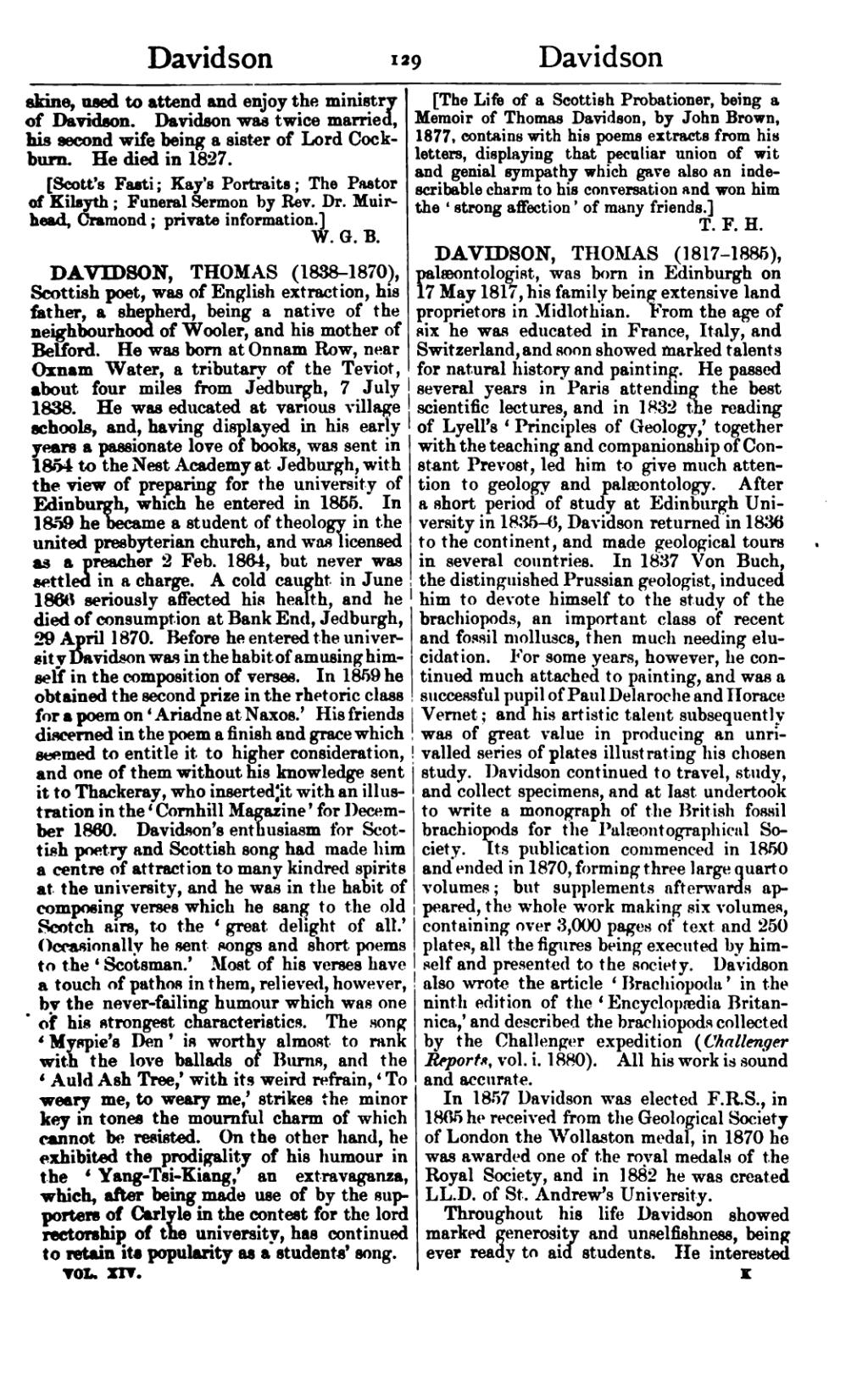skine, used to attend and enjoy the ministry of Davidson. Davidson was twice married, his second wife being a sister of Lord Cockburn. He died in 1827.
[Scott's Fasti; Kay's Portraits; The Pastor of Kilsyth; Funeral Sermon by Rev. Dr. Muirhead, Cramond; private information.]
DAVIDSON, THOMAS (1838–1870), Scottish poet, was of English extraction, his father, a shepherd, being a native of the neighbourhood of Wooler, and his mother of Belford. He was born at Oxnam Row, near Oxnam Water, a tributary of the Teviot, about four miles from Jedburgh, 7 July 1838. He was educated at various village schools, and, having displayed in his early years a passionate love of books, was sent in 1854 to the Nest Academy at Jedburgh, with the view of preparing for the university of Edinburgh, which he entered in 1855. In 1859 he became a student of theology in the united presbyterian church, and was licensed as a preacher 2 Feb. 1864, but never was settled in a charge. A cold caught in June 1866 seriously affected his health, and he died of consumption at Bank End, Jedburgh, 29 April 1870. Before he entered the university Davidson was in the habit of amusing himself in the composition of verses. In 1859 he obtained the second prize in the rhetoric class for a poem on ‘Ariadne at Naxos.’ His friends discerned in the poem a finish and grace which seemed to entitle it to higher consideration, and one of them without his knowledge sent it to Thackeray, who inserted it with an illustration in the ‘Cornhill Magazine’ for December 1860. Davidson's enthusiasm for Scottish poetry and Scottish song had made him a centre of attraction to many kindred spirits at the university, and he was in the habit of composing verses which he sang to the old Scotch airs, to the ‘great delight of all.’ Occasionally he sent songs and short poems to the ‘Scotsman.’ Most of his verses have a touch of pathos in them, relieved, however, by the never-failing humour which was one of his strongest characteristics. The song ‘Myspie's Den’ is worthy almost to rank with the love ballads of Burns, and the ‘Auld Ash Tree,’ with its weird refrain, ‘To weary me, to weary me,’ strikes the minor key in tones the mournful charm of which cannot be resisted. On the other hand, he exhibited the prodigality of his humour in the ‘Yang-Tsi-Kiang,’ an extravaganza, which, after being made use of by the supporters of Carlyle in the contest for the lord rectorship of the university, has continued to retain its popularity as a students' song.
[The Life of a Scottish Probationer, being a Memoir of Thomas Davidson, by John Brown, 1877, contains with his poems extracts from his letters, displaying that peculiar union of wit and genial sympathy which gave also an indescribable charm to his conversation and won him the ‘strong affection’ of many friends.]
DAVIDSON, THOMAS (1817–1885), palæontologist, was born in Edinburgh on 17 May 1817, his family being extensive land proprietors in Midlothian. From the age of six he was educated in France, Italy, and Switzerland, and soon showed marked talents for natural history and painting. He passed several years in Paris attending the best scientific lectures, and in 1832 the reading of Lyell's ‘Principles of Geology,’ together with the teaching and companionship of Constant Prevost, led him to give much attention to geology and palæontology. After a short period of study at Edinburgh University in 1835–6, Davidson returned in 1836 to the continent, and made geological tours in several countries. In 1837 Von Buch, the distinguished Prussian geologist, induced him to devote himself to the study of the brachiopods, an important class of recent and fossil molluscs, then much needing elucidation. For some years, however, he continued much attached to painting, and was a successful pupil of Paul Delaroche and Horace Vernet; and his artistic talent subsequently was of great value in producing an unrivalled series of plates illustrating his chosen study. Davidson continued to travel, study, and collect specimens, and at last undertook to write a monograph of the British fossil brachiopods for the Palæontographical Society. Its publication commenced in 1850 and ended in 1870, forming three large quarto volumes; but supplements afterwards appeared, the whole work making six volumes, containing over 3,000 pages of text and 250 plates, all the figures being executed by himself and presented to the society. Davidson also wrote the article ‘Brachiopoda’ in the ninth edition of the ‘Encyclopædia Britannica,’ and described the brachiopods collected by the Challenger expedition (Challenger Reports, vol. i. 1880). All his work is sound and accurate.
In 1857 Davidson was elected F.R.S., in 1865 he received from the Geological Society of London the Wollaston medal, in 1870 he was awarded one of the royal medals of the Royal Society, and in 1882 he was created LL.D. of St. Andrew's University.
Throughout his life Davidson showed marked generosity and unselfishness, being ever ready to aid students. He interested
